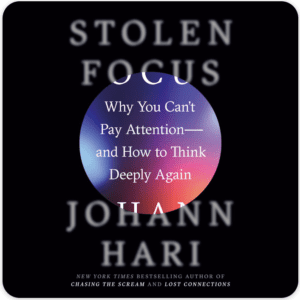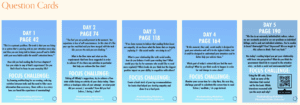 Stolen Focus, Why you Can’t Pay Attention – and How to Think Deeply Again, by Johann Hari, is a game-changer for me. It captures the tension, the friction, the challenge, opportunity and hope that faces education in the face of diminishing ability to think deeply, pay mindful attention, and to learn deeply. This book explores the patterns and trends over time of humanity’s actions that have worked against our focus and attention abilities and skills.
Stolen Focus, Why you Can’t Pay Attention – and How to Think Deeply Again, by Johann Hari, is a game-changer for me. It captures the tension, the friction, the challenge, opportunity and hope that faces education in the face of diminishing ability to think deeply, pay mindful attention, and to learn deeply. This book explores the patterns and trends over time of humanity’s actions that have worked against our focus and attention abilities and skills.
Is this book a bit terrifying? Yes.
Is this book interesting? Yes, it is fascinating.
Is this book hopeful? Ultimately, yes – and encouraging.
You would be interested in this book if you are:
1) Looking to explore personal and systemic causes of our inability to focus
2) Curious about the pace and speed of the world and its implications to education and raising children
3) Embroiled already in a debate / argument / challenge with social media and digital devices
4) Wanting to take back your focus and attention in a world that is trying to steal it
The book begins, and has a thread throughout, of Hari’s personal realization of the impact of the systems and structures in our society that are tugging at our attention and focus. It is this personal experience that makes this book very readable, even as he draws upon in-depth research and interviews with experts in their field. This is not a personal, self-help book, though that may be a part of it; rather, this is an exacting exploration into history, industry and economics and our society.
Skinner Box vs. Mihaly’s Flow
As educators we all know BF Skinner, but perhaps not how influential he was to forming our current education system, and how we think of motivation. At his height, he was on Television, on Government committees, and magazines.
He was highly influential in education thought and practices as well. Watch this:
So, I won’t go into detail, other than to say that Skinner’s concepts are still very much felt today – and some would argue more than ever since school closures due to the pandemic.
Mihaly, was interested in what Skinner’s ideas were lacking:
To Mihaly, [Skinner’s vision] seemed like a bleak and limited view of human psychology… he belived it was missing most of what it means to be human… Mihaly began to wonder if these people [artists] were in fact describing a fundamental human instinct that had not been studied by scientists before. He called it a ‘flow state’. This is when you are so absorbed in what you are doing that you lose all sense of yourself, and time seems to fall away, and you are flowing into the experience itself. (Hari, 55)
Hari uses these two theories to explore parts of our education system, and the impact that social media has on our behaviour. He has a funny anecdote about Skinner’s pigeon dancing and the similarity between that and TikTok dances.
If you’re interested in reading more about the connection between TikTok and social media check out THIS ARTICLE
It is the difference between Skinner’s Box and Mihaly’s State of Flow, that weaves its way through his book, and Hari does it with research and nuance, acknowledging the other sides of the argument and other perspectives as well. His balanced approach is very readable, and provokes me to ask:
How am I promoting ‘Flow’ in my own life and the lives of my colleagues and students?
Inattention: It’s Our Problem, But Not Our Fault
Hari argues that our focus is being stolen in different ways: inattention is systemic, and it is structural, and it is personal and it is caused in a myriad of ways.
Inattention is systemic because IT is a major part of our society, our cultural mores, and feeling of acceptance.
and feeling of acceptance.
Inattenion structural, because IT is integrated into our ways of communicating, understanding, connecting and doing business, and even, yes, education.
Inability to focus and sustain deep focus is personal, because we have our identities wrapped up in IT, and we gain joy, pain, and other very human emotions from IT.
So, what is IT?
Hari cites 12 causes of inattention:
- The increase in speed, switching and filtering
- The crippling of our flow states
- The rise of Physical and Mental Exhaustion
- The collapse of sustained reading
- The disruption of mind wandering
- The rise of technology that can track and manipulate you (Part 1 and Part 2)
- The rise of technology that can track and manipulate you (Part 1 & 2)
- The surge in stress and triggering vigilance
- Deteriorating Diets
- Rising Pollution
- Rise of ADHD Diagnosis and our response
- The confinement of our children, both physically and Psychologically
In each of these chapters, and the other contextual, personal ones, Har is a story telling. He weaves his own personal experience to that of research, to anecdotes of personal friends, colleagues and those brave souls who have shared their experiences with him.
For example, in the chapter on Cruel Optimism, entitled “The Rise of Cruel Optimism: Why Individual Changes are Important, but Not Enough”, Hari uses Oxycontin as an analogy for what is happening more broadly in our society. We are in pain, so we seek a remedy. However, in this case the remedy is the same thing that will hold us back from continued flourishing. But what other choices are out there?
This is one of the problems with Cruel Optimism – it takes exceptional cases, usually achieved in exceptional circumstances, and acts as if they can be commonplace. It’s easer to find serenity through meditation when you haven’t just lost your job and you aren’t wondering how you’re going to avoid being evicted next Tuesday. It’s easier to say no the next hamburger, or the next Facebook, or the next tab of Oxycontin if you aren’t already exhausted and stressed. [Cruel Optimism] tells that it’s pretty simple and that we should just “push the f*cking [Do not disturb button on your phone!] is to deny the reality of most people’s lives. (Hari, 152)
The Duke professor, Lauren Berlant writes that cruel optimism ‘exists when something you desire is actually an obstacle to your flourishing’, that a society or an individual’s relation to a specific object of desire may be self-destructive or harmful. [And asks of us] Is resilience merely a last chance saloon for the maintenance of modes of living that inevitably must fail? Does resilience push the costs of climate change onto communities that can least afford it? Does resilience operate to paper over the cracks rather than to tackle problems at their roots? (https://csahs.uoguelph.ca/cruel-optimism)
In this way, Cruel Optimism is focussing on individual actions, and in so doing, ignoring the system and structural forces at play. We can’t just blame and shame individuals into changing their self-destructive behaviour – it goes much, much deeper than this.
As another example, in the Chapter entitled “The Confinement of Our Children, Both Physically and Psychologically”, Hari explores the role of schools and stolen childhoods. This chapter emphasizes the role that unstructured “Play” can and should play in the lives of our children. Inevitably, Finland emerges as the example to which North American education is compared ~ but this time, it isn’t focused on the content, nor the role nor education of the teachers, nor how teachers are a revered position in Finland; rather, he focusses on the systems and structures of Finland. That children don’t go to school until they are 7 years old, they are given almost no homework, and they attend school from 9 – 2:30PM.
I highlight these two chapters, because they resonate with me: that sometimes I can focus on the individual things that I can be doing differently, when I should or could be stepping back to see the larger picture.
I strongly recommend this book as a starting point for us, as educators to start considering bigger systems and structures at play in our own lives, and the lives of the students that we teach. What does attention look like? Hari quotes James Williams, who, in his 2018 book Stand Out of Our Light: Freedom and Resistance in the Attention Economy, argues that we are, both individually and collectively, facing a crisis of self-regulation.
[James] distinguishes three ‘lights of attention’ that are undermined by the attention economy’s distraction machines: spotlight, starlight, and daylight.
The spotlightof attention enables us to focus on our immediate goals: writing an email, tidying up the house, taking care of a friend. When we get interrupted by online notifications or distracted by an advert, we fracture this form of attention. A study conducted at the University of California, Irving indicated that it takes, on average, 23 minutes to refocus. Due to the frequency of distractions, some of us in fact never reach a deep form of attention.
Starlight shines on our medium-term goals, such as learning an instrument, improving our health, or completing a project. With average social media use at over two hours a day, one can only imagine the range of thwarted achievements.
Finally, daylight supports us to “want what we want to want”. This is the light of our values and long-term goals. Williams warns that undermining our daylight may be the most serious and unnoticed danger of the attention economy.
“When our daylight is compromised, epistemic distraction results. Epistemic distraction is the diminishment of underlying capacities that allow a person to define or pursue their goals: capacities essential for democracy such as reflection, memory, prediction, leisure, reasoning and goal setting.”
(Taken from The Alternative: https://www.thealternative.org.uk/dailyalternative/2022/5/1/spotlight-starlight-and-daylight-social-media)
So what lights might we nurture? What lights might we protect?
When I origninally wrote this post, I had ended it with those two questions above. But this book had ingrained in my thinking, so I’ve been looking and searching for ways to counter this theft of my attention.
Vox Focus Challenge Cards: https://thetandemcollective.com/community/readalongs-archive/stolen-focus
This is a series of cards available above, that will prompt and challenge you and / or your students! I’ll keep digging around for more resources, but if you have any, please add into the comments below – thanks!
